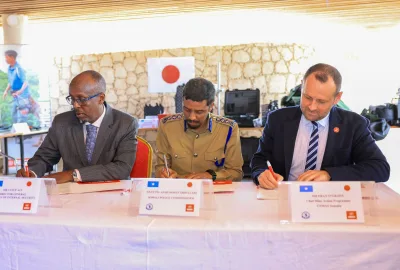At the end of 2016, Somalia will select a new government. The current governing body will…

At the end of 2016, Somalia will select a new government. The current governing body will be replaced by a new administration chosen by 275 parliamentarians, which will be selected by 135 clan elderly. Among those to be vetted and included in the result should be women and youth. However, Somalia is a patriarchal society in which men are dominate, and women are subordinate and awarded to specific cultural roles within their society. The nature and extent of gender disparity differ across cultures, but it is necessary to understand the system that keeps Somali women disadvantaged and to unravel its workings in order to make it a clear focus for women’s development in a systematic way. This article addresses one of the less talked about topics within Somali politics: gender balance and the cultural complexity that creates obstacles for Somali women to participate in shaping their own society and the future of their country.
Gendered culture and its context:
Traditionally, Somali men and women have been interdependent with both genders actively participating in Somali society and production. In the political realm, Somali women were actively engaged in the independence movement and within political organizations. A case in point was the participation of Somali women in the creation of the Somali Youth League (SYL) and its acceptance by the public. However, in the post-colonial era, huge gaps were created between the genders, as men were more strongly encouraged to obtain education and to participate in public political roles. In this context, the historical spirit of workmanship and collaboration between the genders was broken, and women’s participation was not universally accepted. This pushed back women’s ability to participate in the broader political and decision-making discussions and more firmly fixed them to a greater homestead gendered role. Despite their efforts and the societal pride in the resilience and strong nature of Somali women, this high-minded idealism does not match the reality for the majority of Somali women.
Somali governments in the past were aware of the lack of women inclusivity in public life, but have not attempted to address it in a tangible way. It wasn’t until the military region of Siyad Barre came to power that the situation has changed for women, and Somali women had greater access to education and greater freedom to participate in society as civil servants. At this time, the Somali Women’s Democratic Organization (SWDO) was created and although there were already Somali women organizations established in 1960s such as the Women Welfare Association, their reach was not as widespread as that of SWDO. Somali women took advantage of the educational access afforded to them and attended universities inside and outside of the country. Some have argued that the military regime’s women agenda was more of a propaganda tool than actual equality for women; nevertheless, women did have more visibility. With all these early achievements; however, Somali women were and are today still politically excluded in the country’s decision-making process.
Culture is viewed as a people’s way of life including societal norms and values. Somali society is an oral society with messages expressed through poetry, proverbs and other forms of artistic expressions. However, most of female proverbs have given a negative impression of Somali women which may have negatively contributed towards the devaluation of women’s intelligence and worthiness. For instance, there is a Somali proverb that says “naas caano galay aqli ma magalo” which means intelligence and motherhood is incompatible. Rhetoric of this kind is embedded in Somali culture and challenges the ability of Somali women to be taken seriously while contributing to the perpetuation of women subordination. These kind of negative proverbs go against the essence of womanhood and, if unchecked, the devaluation of women will carry on through the male offspring who might grow up with misogynistic views of women. It is imperative; therefore, that the Somali central federal and regional governments create and implement, not only equitable and legitimate power sharing for women, but also educational curriculums that highlight the historical contributions of Somali women within their society and their shared values in decision making and leadership. Direct State intervention through legislation and educational awareness could lead to a new consciousness of gender analysis and greater access to Somali women’s historical narratives, and perhaps to a greater acceptance of political power sharing today.
Today’s politics and cultural complexity:
Today, it is accepted that Somalia’s conflicts and related disasters are self-inflicted and arose from a combination of brutal military regime, civil war and dysfunctional governance. The lack of gender policies, which is reflected in the absence of women’s voices in key decision-making on strategic issues such as nation building, institutional reconstruction and peace within the country, is a manifestation of the collapse of national governance. Somali women have faced many barriers throughout history, but none was more serious than during and after the civil war, when women became breadwinners for their families, while continuing to care for the sick, the old and the orphans. As a society, women’s role as mothers and wives are well respected, but the issue is much more than the assigned roles and constructed gender privileges; it’s about equality and fairness. Thus, the questions that should be asked are: do the Somali women have access to the country’s decision-making process and do they have adequate representation in the political and social development of their country? The answer is an emphatic “no” on both counts. Therefore, there is a need to have an honest discussion on the status of women in Somalia today. And since the necessary transformation of the status of women in Somalia cannot be achieved through voluntary means alone due to the entrenched patriarchal viewpoint, it is vital that the change be driven by gender responsive legislative measures and policies that can translate into commitments.
The 2012 Somalia Provisional Constitution set out women’s representation in the Federal Parliament at 30%; that is 83 of the 275 seats to be taken by women. In reality, however, only 14% of seats were actually given to women, mainly because of the reluctance by the clan elders who selected the members of parliament. This unconstitutional practice was tolerated both by the government and the representatives of the international community who were acting as guarantors for the implementation of what was considered to be an article of faith for modern Somalia. In this context, the men at the helm tolerated this blatant infringement of the constitutional understanding, which further strengthens the case for strong legislation to uphold the constitution.
Somalia is going to a parliamentary election in August 2016, using the clan selection process again with a proposal to allocate women 30% of the seats; this looks like 2012 all over again. Given that some of the clan elders and political leaders throughout the country have shown a complete disregard of the constitution on the issue of women’s representation, it is vital to make the process more robust and outside of political control in order to have the desired outcome. For example, by separating the percentage of women from the general distribution of clan selection or reserving their seats as unoccupied unless clan elders bring women to fill it, will give the process credibility.
The Way forwarded:
For governments to succeed in today’s environment as well as in the future, they must develop in their people an understanding of good governance. For this to happen, a strong leadership is required. It has become commonplace in Somalia for people to view the government as mired in legislative gridlock due to a lack of capable leadership. In fact, the whole society is trapped in a reactive cycle of restructuring, reengineering and reconstituting in the hope that credible leadership will emerge. Somalia needs Somali women and this is a fact known to all Somalis, but few men speak of it. The late professor Said S. Samatar (God rest his soul) articulates this point well in his article ‘Somalia’s Horse that Feeds His Master’:
Bring Somali women into the peace process. If paternal kinship ties counted through patrilineal descent has traditionally served to integrate Somali society into constituent lineages vertically, Somali women, by marrying into one clan while belonging to another, have exercised a powerful pull toward horizontal integration on society. To put it differently, the male principle in Somalia cuts up society into vertically organized mutually antagonistic lineage units, there by tending to divide it; while the female principle cuts across clan lines and hence creates horizontal blood ties, thereby serving to unify society. This unifying potential should be cultivated in efforts to reconcile and reconstruct Somalia (Samatar, 1996).
Somali women’s political and social contributions to the society are not in question, what is in question; however, is whether or not Somali men who have grown up within a clearly patriarchal culture are willing to stand-up to the occasion, and in order to bring this country back from the brink, are willing to accept an equal partnership with women? It must be acknowledged that men are not the default leadership; their failure in leadership has been shown time and again. Therefore, it is not unreasonably to suggest that women should be considered as effective political leaders. Having said that Somali women must, themselves, seek to organize and become active players of all levels of the decision-making process in their society, including the management of conflict within the country.
Suggestions for change:
- Create comprehensive strategies to develop sustainable programs on women’s issues, and in particular, a strategy to remedy the current gender imbalance in political participation and representation in parliamentary selections.
- Identify opportunities to develop equitable legislation and gender-sensitive programs that are conducive to change.
- Recognize the effective contributions of Somali women in the country’s leadership within both public and political organizations
- Approve the right of Somali women to partake in the current and future Somali government (s) with a guaranteed 30 % quota and with consideration given to increasing further the quota to narrow the historical gender gap in the country.
- Accept Somali women’s involvement in all leadership roles within the Somali government without reference to cultural or gender biases that render ineffective their contributions to the country’s affairs.
- Utilize Somali women’s talents more broadly in public office and private- enterprise.
- Engage in social, political and cultural awareness campaigns to promote the contributions made by Somali women in all aspects of political, social and cultural development of their country.
Somali women, rather than returning to a state in which their status and positions are defined for them, need to seize the opportunity to define the roles they wish to play in the country’s future. Such a movement can only exist if women and men can unite to map out together the future for an egalitarian society that we can all be proud of. Cultural patriarchy does not serve to benefit the whole country; therefore, a new and an inclusive culture need to be constructed. Somali statehood faces extinction, unless Somali leaders and the greater society enact meaningful and dramatic change—this need to be done soon before it is too late.
Farhia Ali Abdi.
References:
Samatar, Said S. Somalia’s Horse That Feeds His Master: African Languages and Cultures. (1996), pp. 155-170. Published by: Taylor & Francis, Ltd.







